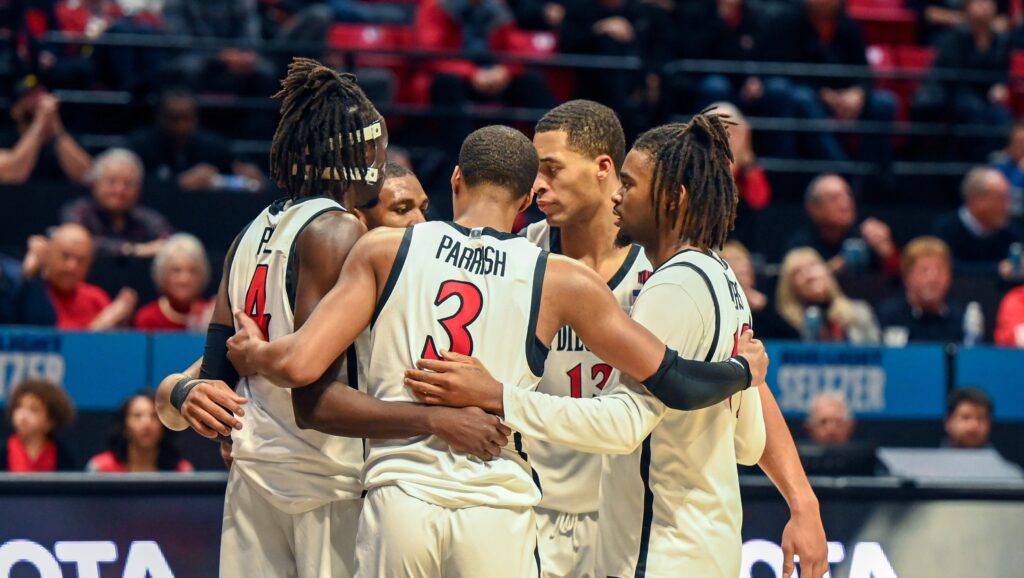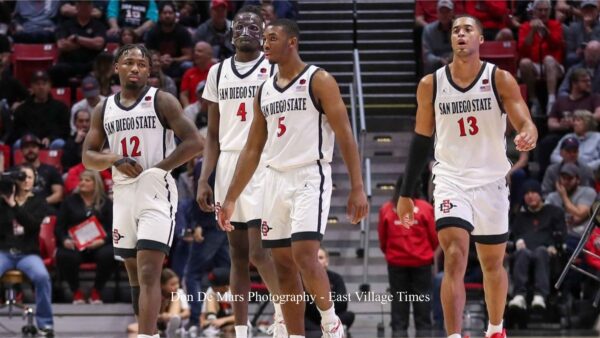SDSU vs. Nevada: Aztecs prepare for return trip to Reno

SDSU huddles during a break in the action. (Deanna Goldberg/EVT)

SDSU defeated Nevada 71-59 at home on January 17 in the first half of the Mountain West schedule. On Friday, the Wolf Pack host the Aztecs for the second leg in the home-and-home series.
Prior to the first meeting, EVT published a preview of how the two teams match up. That article is still relevant for this game and can be found here.
Since the two squads have already played, rehashing much of the same information is not ideal. Instead, this article will focus on what went well for the Aztecs in the first matchup, what did not go well, and what adjustments can be expected from both teams.
What worked well
Among the reasons SDSU controlled the first game against Nevada was the poor outing by Jarod Lucas. The Wolf Pack’s star had more shots (10) than points (9).
One key to slowing down Nevada is making Lucas work for his shots. The Aztecs accomplished that by switching all screens Lucas was involved in, even if it meant leaving LeDee out on an island.
Jaedon LeDee doing a good job containing Jarod Lucas on the switch. pic.twitter.com/iKhut2xvlS
— Aztec Breakdown (@aztecbreakdown) February 9, 2024
Another goal that worked out in the Aztecs’ favor was offensive rebounding. SDSU collected 20 missed shots, totaling over half of their misses. Getting extra chances to score tipped the scales and will be something the team tries to replicate in Reno.
Aztecs dominated the offensive glass last time against Nevada. pic.twitter.com/SF7zrjXoiS
— Aztec Breakdown (@aztecbreakdown) February 9, 2024
Expected Nevada adjustments
Nevada’s first priority will be to fix their defensive rebounding. It’s hard to win without getting stops. As tempting as it will be to run on offense and score easy points quickly, they need to secure the ball first, so expect them to work on this fundamental and also send more players to the paint.
The Aztecs should continue to deploy guys like Jay Pal and Elijah Saunders to sneak in and get rebounds because doing so will have one of two results.
Ideally, SDSU would once again dominate the offensive glass and gain extra possessions. If not, putting pressure on Nevada to keep more players in the paint to box out will limit their fast break offense, giving the Aztecs time to set up in the half court, either outcome is positive for SDSU.
Nevada’s other main priority will be getting Lucas open looks. There may not be a need for an adjustment to be made to accomplish that. Nevada might simply continue to run their sets and try to execute better this time. Lucas struggled in Viejas last season but played much better in Reno, so there is precedent to trust the process.
If there is an adjustment, it will be something small. Lucas may make more post entries, so he is open off the double team. They may add a counter to a plan to take advantage of SDSU overplaying a screen.
The last adjustment will be in their screen defense. Nevada went over most screens in the first matchup. The games SDSU has lost involved packing the paint and forcing the Aztecs to shoot from outside. Going over screens encourages the opposite. Expect the Wolfpack to go under most screens this time.
Nevada went over many screens in the first matchup. Expect them to go under more often and force SDSU to beat them with jumpers. pic.twitter.com/cuWrvz2HdV
— Aztec Breakdown (@aztecbreakdown) February 9, 2024
Expected SDSU adjustments
The first adjustment to look for for SDSU is how they run their offense when LeDee gets the ball in the post. Nevada used the same defensive rotation in the first match that they have used all year. The only difference is they sent the double team right as LeDee caught the ball rather than waiting for someone to cut through the lane to send the double off the cutter. The setup SDSU used was something that can be improved.
At times, Brian Dutcher’s designs worked out, as in the clip below. Butler attacked the rotating defense, drew extra help, and kicked to an open shooter. The cut by Reese Waters also kept Kenan Blackshear from fully recovering to the corner.
The only question at that point was if Saunders was the best player to take that final shot. One minor adjustment could be having Waters in the weakside corner instead of Saunders and running everything else the same. That way, the team’s best shooter is left open.
Butler does a good job attacking off the close out, draws defenders and kicks the ball out for an open look. pic.twitter.com/vpXt0CNN4n
— Aztec Breakdown (@aztecbreakdown) February 9, 2024
A different adjustment could be having Waters make the post-entry pass from the wing. That way, the second defender has to leave SDSU’s best shooter open, and if the other rotations are even a half-step slow, Waters would get a good look.
An example of what not to do is in the next clip. It’s the same entry by SDSU, and the same rotation by Nevada, but it did not work well. Saunders’ cut drew extra defensive help, but the weakside pass out of this setup is hard to make. It is possible LeDee did not even see both Waters and Miles Byrd wide open on the weak side. By the time he got the ball out of the post, the defense had mostly recovered.
The timing was off multiple different times when trying to beat this double team. pic.twitter.com/Ns8zGAuYCV
— Aztec Breakdown (@aztecbreakdown) February 9, 2024
A simple change would be to have the player making the entry pass cut to the basket. Modeled in the example below, this tactic would be especially effective if Pal delivered the initial pass. It would be easier for LeDee to get a pass over the defense to a cutting Pal heading for the rim than it would be to swing the ball all the way across the court. It’s something the Aztecs started doing during the Utah State game, and they should continue doing it.
Jay Pal with the ghost cut and LeDee with the excellent touch pass is the best way to beat the double. pic.twitter.com/iBRHSPuSA1
— Aztec Breakdown (@aztecbreakdown) February 9, 2024
Small tweaks like that can help the offense score more.
Swarming Kenan Blackshear defensively worked well, so we should not expect a change there. Even though it led to guys like Tre Coleman having a big game, it is a trade-off worth making. The Aztecs will continue to swarm both Blackshear and Lucas and dare someone else to beat them.
Aztecs build a wall against Kenan Blackshear. pic.twitter.com/PtfdBMPwOo
— Aztec Breakdown (@aztecbreakdown) February 9, 2024
X-Factor
Outside shooting. The Aztecs should not expect to get as many second chances or foul calls as last time. They will need to make up for those lost opportunities by being more efficient behind the three-point arc. Similarly, preventing Wolfpack shooters from getting hot is always a priority.
Native San Diegan living in Montana. Big time Aztec Basketball fan. Creator of Aztec Breakdown. Hoping to help people enjoy basketball more by increasing their understanding of it.